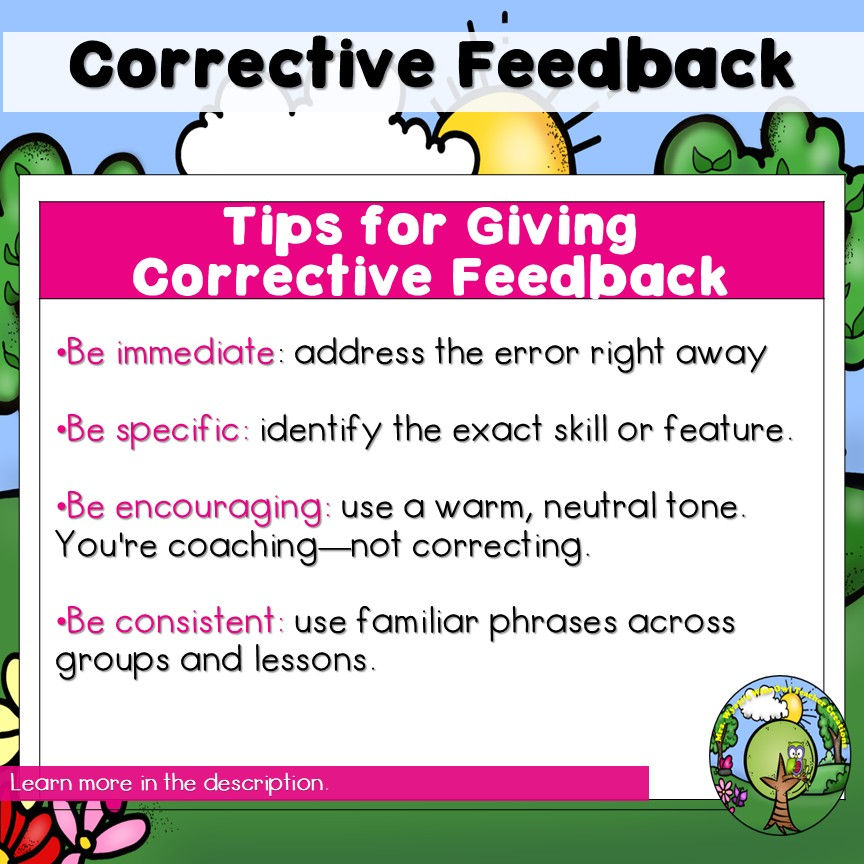Corrective Feedback in Reading
- Mrs. Wyatt's Wise Owl Teacher Creations

- Jul 31
- 4 min read
Ever find yourself in that moment during a small group reading lesson when a student misreads a word—and you're unsure how to respond? You're not the only one. Giving corrective feedback during reading instruction can feel uncertain. Say too little, and students continue to guess. Say too much, and you may take over the thinking process. In this part two series on What Is Diagnostic Teaching? the focus will be on corrective feedback.
Effective corrective feedback for reading doesn’t rely on a perfect script. It comes from recognizing what the student needs and responding in a way that supports their learning. In this post, we’ll look at what that sounds like in real classrooms—and how to use practical corrective feedback techniques to help students grow as readers.
What Is Corrective Feedback?

Corrective feedback is how we respond when a student makes an error during reading or writing. In a Structured Literacy classroom, it’s more than just saying, “Try again.”
It’s purposeful. It’s timely. It’s designed to support the learning process—not just fix a mistake in the moment. Think of it as a nudge forward—not a push or a pull. You’re guiding the student, but they’re still doing the thinking.
Why Corrective Feedback Matters
Research consistently shows that corrective feedback for students—especially when it’s immediate and specific—strengthens long-term learning and helps correct errors efficiently. In fact, Edutopia emphasizes that the most effective feedback is actionable, student-focused, and timely—a principle that aligns perfectly with the structure of small group reading instruction. (Edutopia, 2023)

When done well, corrective feedback supports:
Phonemic Awareness:“You said /t/, but this is /ch/. Let’s try that again.”
Decoding:“Look at the vowel in the middle. What sound does ‘a’ make when there’s a silent e?”
Spelling:“You wrote sed, but the past tense of say is an irregular word. Let’s spell it together.”
Fluency and Comprehension: When an error disrupts meaning or phrasing, corrective feedback techniques help students regroup and reread with purpose.
The goal? Not just accuracy, but independence, metacognition, and confidence.
Examples of Corrective Feedback in Action

Let’s take a look at some types of corrective feedback you can use during reading instruction:
Phoneme-Level
Student says: “rat” for rate
You say: “Let’s slow it down. What do you see at the end of this word? Yes, that silent e changes the vowel. Try it again.”
Grapheme-Level
Student reads: shop as “sop”
You say: “Let’s listen to the beginning of the word. What sound do you hear? /sh/. How do we spell /sh/? Yes—s and h together. You read it with /s/. How do we spell /s/? Just s. Remember, a digraph makes one sound but is spelled with two letters. Let’s try it again.”
Spelling
Student writes: fog for frog
You say:“Let’s take a closer look. You wrote fog, but that’s missing a sound. Let’s tap and say the sounds in frog—/f/ /r/ /o/ /g/. What sound comes right after /f/? Yes, /r/. The word frog begins with a consonant blend—two consonants that come together, but you can still hear both sounds. What blend do you hear at the beginning of frog? /fr/. Now let’s write all the sounds we hear: /f/ /r/ /o/ /g/. What letters spell those sounds? Yes—f-r-o-g. ---> Write the word: frog
Note: The teacher could have the student tap and read each sound in the word to selfcheck that the word was spelled correctly.
Fluency
Student reads: “The… cat… sat… on… the… mat.
You say: “Let’s read that again with smoother phrasing. Imagine you’re telling me a story. Ready?”
These responses give just enough information to support the student without taking over the task. Each prompt is intentional, focused on helping the student reflect, correct, and apply knowledge independently. When feedback is grounded in the principles of Structured Literacy, it becomes a powerful tool for building accuracy, confidence, and long-term application of skills.
How to Give Corrective Feedback That Works

You don’t need to correct every single error. Focus on skills you’ve explicitly taught. If you're working on digraphs, prioritize those. If you’ve just introduced vowel teams, that’s your anchor.
Corrective feedback for reading should feel like a supportive exchange—not a test. Use prompts that invite the student to reflect and revise:
“Let’s check this one. Does each sound match the letter(s)?”
Skill: Supports sound-symbol mapping and phoneme awareness.
“You said _____ vowel sound, should the vowel say it's long or short sound. Why?
Skill: Supports sound-symbol mapping and phoneme awareness.
Let’s compare the sounds and spellings.”
Skill: Promotes contrastive analysis and self-correction.
“Say and tap each sound in your spell of the word _______. What word did you spell?"
Skill: Encourages self correction of possible errors.
These small shifts help build problem-solving skills and reading resilience.
Final Thought
Corrective feedback isn’t about catching mistakes. It’s about teaching students how to catch them themselves. When we respond with clarity, consistency, and care, students feel safe to take risks—and they learn to read with understanding and confidence.
So the next time a student stumbles, offer a cue that supports—not solves. You’re not just helping with one word—you’re giving them tools to tackle the next hundred.
Be sure to read Part 1 of this series, What Is Diagnostic Teaching? How Teachers Use It to Guide Reading Instruction
Want more practical strategies like this? Join my email list to get free resources, classroom tips, and tools aligned with the Science of Reading and Structured Literacy.











Comments